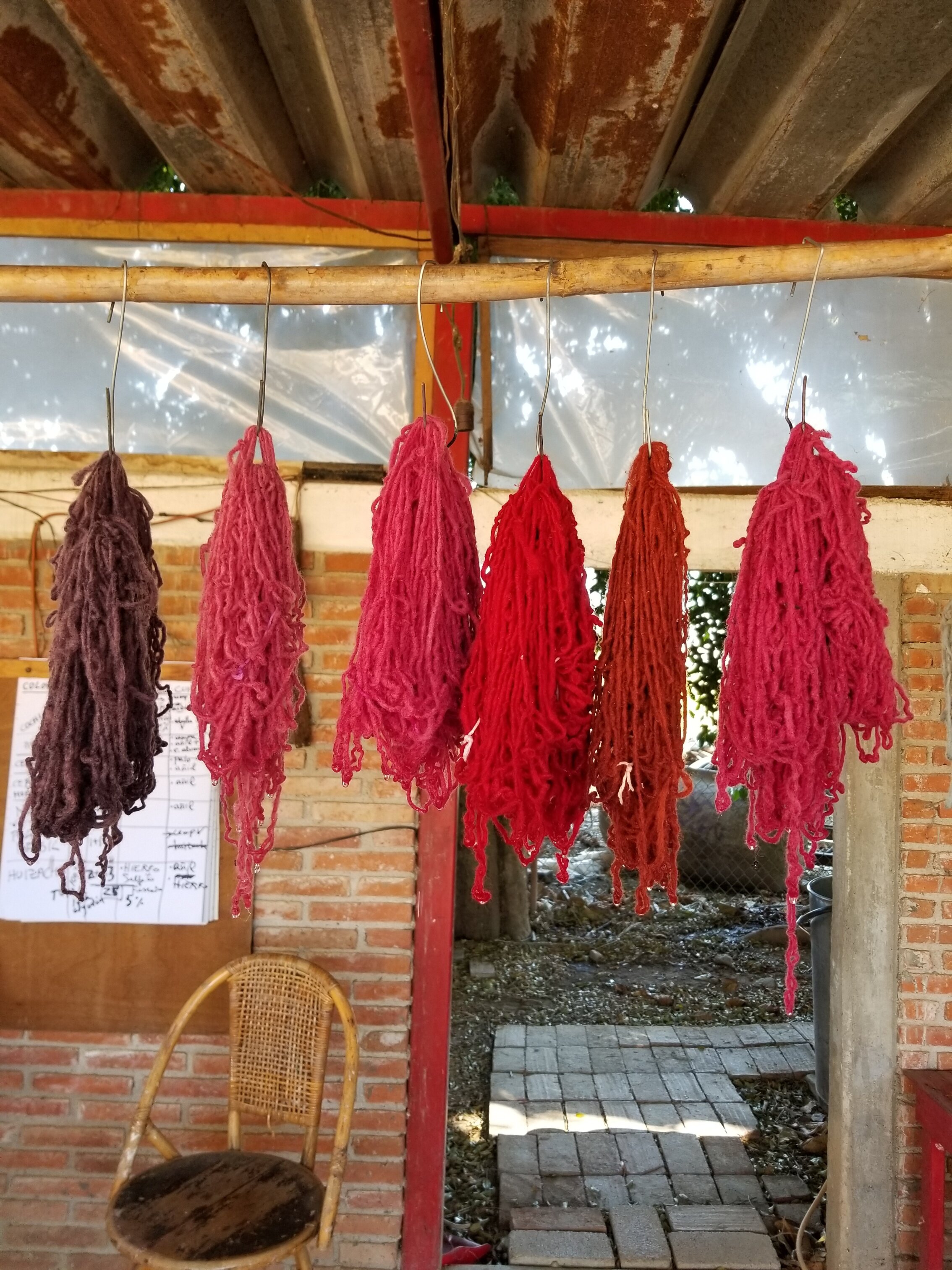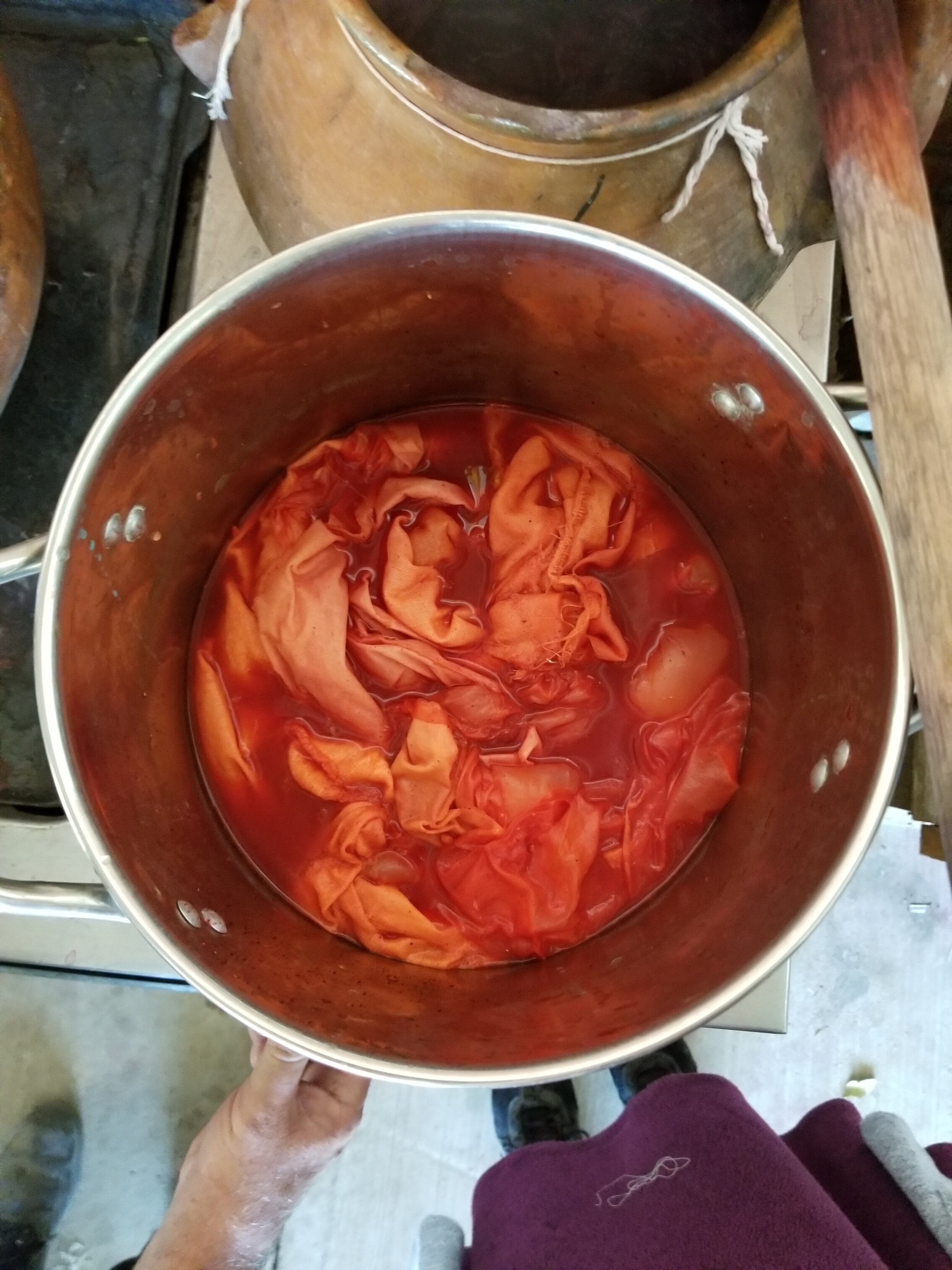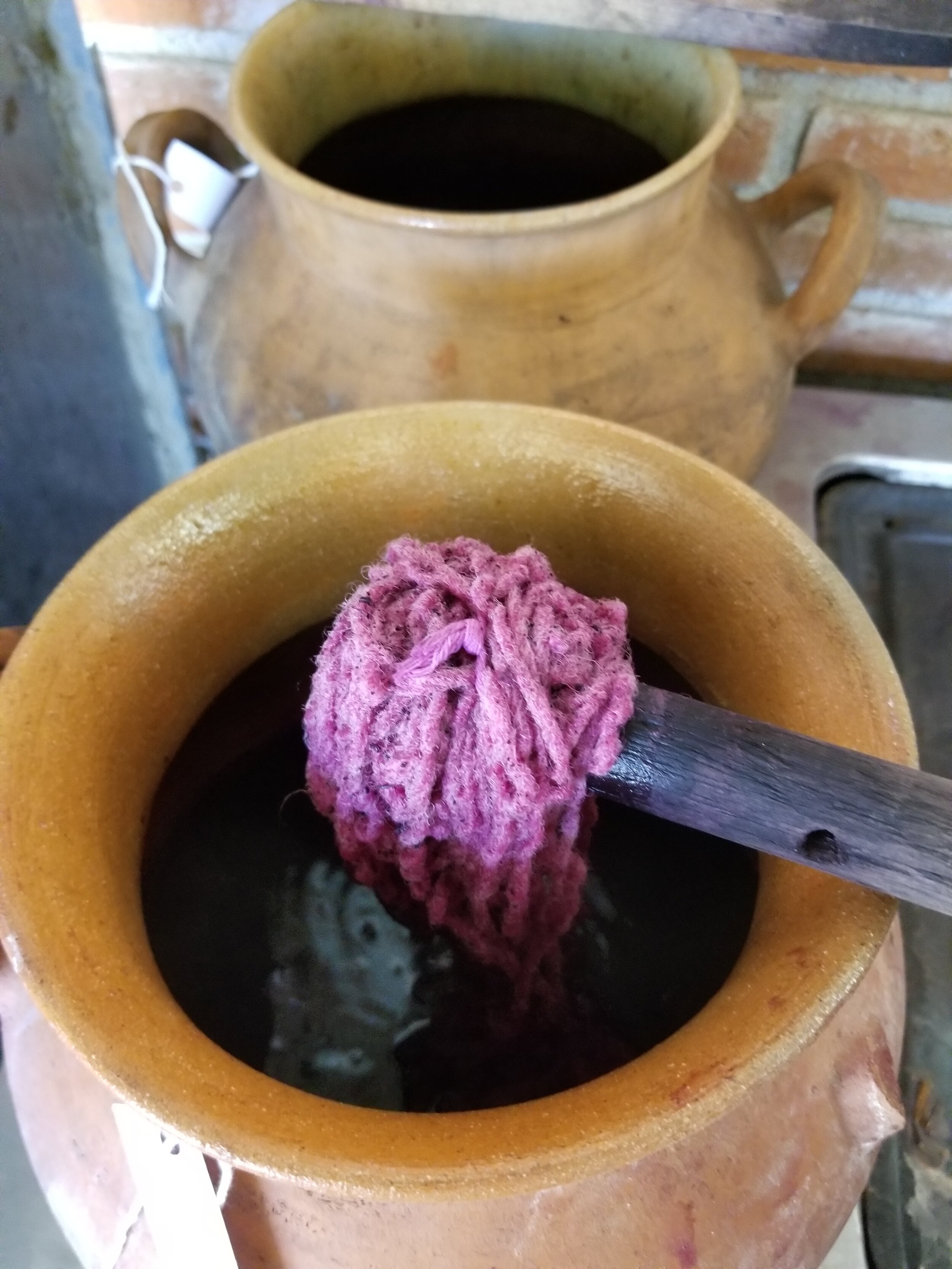The stuff of rainbows
Don’t know about you, but I have a handful of tricks up my sleeve to remember trivial bits of information. I am the maven of mnemonics:
Need to know how many days there are in April? Got my knuckles for that.
That 5 letter Great Lake messing up your crossword puzzle? Try H.O.M.E.S. on for size.
Pulling out the crayons to draw your sweetheart a rainbow? I’d like you to meet Mr. Roy G. Biv
I think it was my grade school art teacher, Mr. Malley, who taught us how to remember the seven colors of the rainbow. (Yes, I had a full time art teacher with a dedicated art room when I was a kid!).
Mr. Biv has been a tool in my paint caddy ever since.
The organic colors of the rainbow hand-dyed on paper in my residency studio in Oaxaca, Mexico.
So, of course, Mr. Biv was my travel companion to my artist residency in Oaxaca, Mexico, last month as I continued my quest to find the rainbow in nature’s palette. Let’s just say, we found all seven of his colorful letters and then some!
Red
The color of love (among many other things) is a highly sought after hue that has a history connected to imperialism and revolution. Minerals of hematite and cinnabar, the root of madder and several parasitic creatures have been foraged and crushed so we can bathe in red.
One insect in particular has become the darling in the wide world of dye: cochineal.
I had only bumped into cochineal about a year ago when I was preparing for my residency in Iceland. Visiting a dye master in the countryside two hours north of Reykjavik, Guðrún Bjarnadóttir shared the secret sauce of her scarlet wool yarn.
The gorgeous hand-dyed Icelandic wool of Hespa Iceland. Looks like a neutral cochineal soak to me with those bright fuchsias peeking through.
She had a large jar of cochineal that she imported to Iceland as her ancestors had done before. You see, red and its variations are not natural colors found in Iceland.
Cochineal is a parasite that lives on the nopales cactus indigenous to present day Mexico and Peru.
The white powder of the cochineal insect dusting nopales cacti before harvest.
Contrary to what you may think, the red comes from carminic acid, not blood, which acts as a deterrent against predators. Or, if you are human, it seems you are wildly attracted to it!
Working for three weeks on a cochineal farm in Santa Maria Colotepec in Oaxaca, Mexico, the secrets of its beauty were slowly revealed to me.
All the lovely shades of cochineal hanging out in wool yarn on the farm near Oaxaca, Mexico.
But, not only did this tiny insect produce the most amazing carmine color, it played a starring role in many of Mr. Biv’s letters.
Orange
Beyond the measurements I wrote about in last month’s Trail Tale, dyeing incorporates some elements of chemistry.
Who remembers those little litmus strips from your high school lab? Well, turns out cochineal is sensitive to the pH level in the dye bath. Add a bunch of lemon juice, aka. acid, and mira - orange!
Shifting cochineal neutral by squeezing lemons. The secret of playing with pH!
Makes me chuckle to think that adding yellow to red actually makes orange in this corner of the dye world. Trust me, that isn’t a hard and fast rule in dye chemistry, but cochineal happily plays along.
Yellow
I know what you’re thinking: lemon juice must be a key ingredient in yellow dye. Nope. I have recently seen Sasha Duerr, a natural dye specialist, create yellow from citrus skins, but in Oaxaca, we used pericon.
You may know this native herb as Mexican tarragon or marigold, both of which are used as dye in other parts of the world. The pericon grown and harvested on the cochineal farm, however, produced a gloriously vibrant yellow that demanded visual attention.
The green leaves of pericon cooking up some instense yellow on silk strips I used for installation in Oaxaca.
Move over marigold – you may have a rival nipping at your heels, but pericon may be tough to find in my local PNW nursery.
Green
When it comes to the plant world, it’s not easy being green.
Both, Guðrún Bjarnadóttir and Manuel, my Oaxacan dye master, utilize the primary color theory to achieve green. First you dye with yellow (pericon or another yellow source), and then you over-dye with blue (indigo), another elusive color rarely found in nature. Voila - green!
Although I attempted this on the farm with my wool yarn samples, I struggled with the indigo (more on that below). That didn’t stop me from experimenting in my own dye studio on days away from the farm, and I had some success.
Who knew the cold sludge of fermenting black beans could tease out such gorgeous greens?
No over-dye step required here. Just a 2 day cold soak in fermented black beans!
I was expecting a grayish blue dye result when I bought the dried beans in the Mercado 20 de Noviembre. You just never know with natural dye - the surprise element is one of its sweetest characteristics.
Blue
If you think red is tough, you haven’t met blue yet. Treasured minerals of lapis lazuli and azurite are pigments of royalty. In the plant kingdom, indigo is queen.
The cochineal farm is an educational venue exclusively focused on the natural dyes of the region, and indigo has roots in the tropical climate of the Oaxacan coastline. Manuel grows every plant we used on the farm, but his indigo suffers in the dry heat. So, as traders have done for centuries, Manuel brings his indigo crystals from the coast.
Grinding indigo with mortar and pestle before adding it to the dye pot.
Extracting color from indigo is a labor intensive process and one that requires humility and reverence. I was quickly humbled by the mystery of blue.
Indigo
With all the work that went into making 12 dye pots to create 40 unique colors over three weeks, saving indigo for last didn’t surprise me. However, I soon realized that rushing indigo at the end did not honor its spirit, and so it did not fully share its color with me.
The many shades of indigo from an ignored dye pot hanging out with no-fuss cochineal orange.
When I explained how tough my day with indigo had been, a local artist told me the secret of the blue goddess: one must be fully present without distraction or haste.
I love this thought. It rings true across so many aspects of life, and so now indigo is yet another gentle reminder of the beauty of presence.
Violet
The last letter in Mr. Biv’s name was a dual effort in the organic realm. That sneaky, chameleon of a dye, cochineal, can be shifted to a yummy color of the violet persuasion. All the alchemist has to do is sprinkle in minerals (various recipe options) which can shift the pH balance to alter the hue.
Cochineal neutral plus 15% alum working its violet magic!
No minerals to be had – no problem: muicle to the rescue! Picking the leaves of this medicinal shrub on the farm produced a lovely violet dye as well. I doubt these leaves are sold in my local farmer’s market, so they may be a color treat solely for the Oaxacan palette.
Dye me a river
The colorful experience I was so lucky to have in Oaxaca is not soon to be forgotten. Just ask Mr. Biv.
But, that hasn’t stopped me from building my own mnemonic device to capture some of the amazing tips I learned, and a few of the easy kitchen recipes that can produce a rainbow.
Feeling inspired to get your dye on now? Click here for the Cookin’ Color Brew Booklet to see if you can catch Roy G. Biv just like I did!
xoxo - Byrdie










